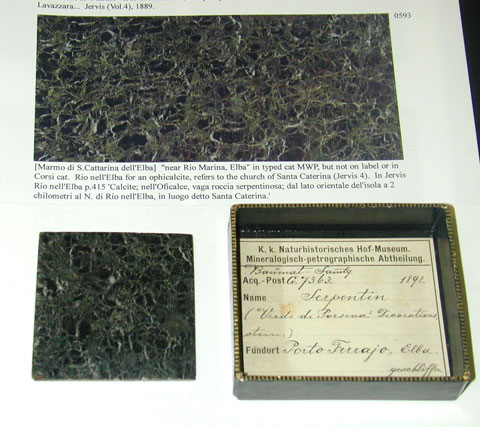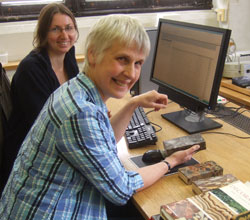The Corsi project
Faustino Corsi always intended his collection to be used as a reference to help identify polished stone, and he stressed the importance of recording quarry locations. The Corsi project has revealed and corrected a number of his errors. It has also enabled us to image all the stones with a standard colour reference. The Esmée Fairbairn Foundation has generously funded this website, and now we would like to hear from you about your experience of using it.
The importance of quarry location
Decorative stones are commonly named after the place they are quarried, and Corsi wanted to record this information for all his stones. Other early collectors rarely noted more than the archaeological excavations from which a stone was obtained; incidentally something that Corsi rarely mentions. Occasionally, Corsi gives a name that refers to a place where a stone was used, for example breccia del Giannicolo or marmo del Duomo. In a few cases, such as breccia di Ponte Salaro, it is ambiguous whether he is meaning an excavation, where the stone was used, or where it was quarried.
Problems with provenancing ancient stones
The ancient Romans quarried and brought to Rome such huge quantities of decorative stone, that succeeding generations simply used the stockpiles and forgot where the quarries were located. Corsi could only speculate where the quarries were, drawing on the writings of ancient authors such as Pliny the Elder and Theophrastus, the oral traditions of the scalpellini, and the published works of contemporary authors. He explained:
‘It was... most difficult in the case of the ancient stones. Writers who incidentally mentioned the subject, and those who specially treated it, failed even to inform us of what substance the stone consisted, or of any of its characteristics. They gave only a dry description of the colour, and the form of the stain. The names used were generally derived from the location of the quarry, and as these were written in Latin or Greek, it was necessary to compare them with the common names invented by the stonecutters.’ i
The quest to rediscover the Roman quarries was begun in earnest by stone merchants, explorers, archaeologists and geologists when ancient marble became particularly fashionable in the late 19th century, and has continued right up to the present day. In 2000, Cooke ii reviewed Corsi’s attempts to provenance ancient stones, and she discusses his sources and methods. Sometimes Corsi’s conjectures have been confirmed as correct, but often he was mistaken.
Unexpected problems – the modern stones
Regarding quarry localities, Corsi confidently wrote ‘It was easy to obtain this information concerning the Italian stones’iii , but it appears that no researcher had ever checked in any detail the veracity of Corsi’s information for his ‘modern’ samples. Even William Brindley, at that time the greatest authority on marble in Great Britain, queried very few of the provenances. A degree of complacency regarding the accuracy of Corsi’s catalogue was to become firmly established.
We were alerted to a number of errors by Professor Lorenzo Lazzarini of the University of Venice, during his visit to see the collection in 1998. The following year, when a Jerwood Cataloguing Grant enabled us to photograph and progress the research on the collection for this catalogue, the entire collection was taken out of its storage cabinet and laid out in one room. This was perhaps the first time it had ever been seen in its entirety in this way, but it revealed a number of further errors. Samples so well matched that they could easily have come from the same boulder were attributed to entirely different provenances. Some samples were the wrong age or were a kind of rock that did not occur at the locality recorded by Corsi. Certain others were misidentified by Corsi, in turn casting doubt on the accompanying provenance data.
It is possible that Corsi’s use of agents to obtain samples left him vulnerable to exploitation, for he would have found it difficult to prove that two nearly identical stones had not come from entirely different places. This is entirely plausible for example, for samples of the Scaglia Rossa Formation, a pink pelagic limestone which extends across considerable areas of Italy. It is far less likely for the several samples of the distinctive Lumachella di San Vitale, which Corsi has classified variously as a lumachella and an albaster, and as coming from Milan and Cremona as well as the correct locality north of Verona.
The problem may have been exacerbated because the various states which make up modern Italy were in a state of political and social turmoil; they also had much stronger linguistic differences than is the case in modern Italy. It is important to bear in mind that when Corsi was writing, spellings of place names were by no means as consistent as they are today. Corsi’s own understanding of Italian geography was sometimes at fault, for example, he repeatedly makes the error of stating towns and villages to the north of Verona are in the Euganean Hills.
It should be remembered too, that corrections made once the type was set would have added substantially to the time and cost of printing a catalogue. Many of the small errors in Corsi’s data which have made the checking of his ‘modern’ localities so much more challenging are probably of a typographic nature. The village of Malcesine on the coast of Lake Garda, a source of three specimens, illustrates this point. It is printed ‘Malfesine’ (no.21), ‘Malsosina’ (no.179), and ‘Malsesine’ (no.464).
Another kind of error may have been introduced because foreign stones imported into Italy for processing, were routinely given Italian names, and may have inadvertantly been given an Italian provenance. An example is a typical Belgian rouge griotte which Corsi says was from Brescia in Lombardy.
Another potential source of error may be of a curatorial nature. Corsi already had at least 900 specimens when he sorted his collection into a geological order and wrote his Catalogo ragionato. His numbering system is based on his published catalogue and there is no evidence of an earlier methodology to link the right information with each specimen. Consequently, it is entirely plausible that some specimens may have been muddled before he had begun to draft his catalogue.
Our database – what we know today
We now know much more about the names, provenances and geological contexts of Corsi’s stones, and we have built a database to record all our modern knowledge about the stones – what they are, and where they are from. This is based on the opinions of visiting experts, and information we have obtained from published sources such as Guglielmo Jervis’s 1889 volume on the building and decorative stones of Italyiv, and by examining specimens in other collections.
With the assistance of other University of Oxford geologists, we give a brief geological description for each specimen based on hand-specimen characteristics. This enables us to correct some of Corsi’s geological mistakes, and make the collection more useful as a reference for identifying polished stone.

A specimen in the Vienna collection (below) and Corsi’s specimen (above) confirm Corsi’s identification.
Pictures of the stones
In 2011 we made high resolution digital images of all the stones, developing a superb digital archive of this important collection. Both Corsi’s catalogue and our modern database link to these images so the user can see in detail exactly what each stone looks like.
With the exception of a small number of translucent or transparent stones, all specimens were scanned on a Canon Canoscan 8400F flatbed scanner with a Kodak Q-13 Colour Separation Guide. Colour rendition is a difficult subject. Relatively few users have colour-calibrated display screens, and the colour seen by the user will depend on their eyesight, lighting conditions and display screen set-up. The colour reference, scanned in exactly the same way as the specimens, is shown below for reference, and can be compared with the user’s own Q-13 Colour Separation Guide colour chart to evaluate display screen colour balance. But polished stone is a natural material that will always show a certain amount of colour variation.

Kodak Q-13 Colour Separation Chart scanned at the same setting as the stones.
All images of the stone are copyright, but may be copied or printed out for personal research. Please contact us if you wish to use any of the images for publication or any commercial purpose. For further information, please see the Conditions of Use.
Can you help us?
We welcome feedback about this website. Please tell us about your experience of using the website, whether good or bad. We want to know how it is being used, and your feedback can help us improve the site.
We would also like to hear from other experts who recognise stones on this website and can tell us more about them. We would especially like to know more about the stones with quarry locations that we have not been able to confirm. For our contact details, go to Contact us.

Monica Price and Lindsay Percival working on the Corsi Project.
i Corsi, F. (1825), Catalogo ragionato d'una collezione di pietre di decorazione. Da' Torchj del Salviucci, Roma, 8. (trans. M.W. Porter).
iiCooke, L. (2000), 'The Corsi Collection: review of some of the original provenances' in L. Lazzarini (ed.) Interdisciplinary studies on ancient stone : proceedings of the sixth international conference of ASMOSIA, Venice, 2000, 531-536. Ausilio Editore, Padova.
iiiCorsi, F. (1825), Catalogo ragionato d'una collezione di pietre di decorazione. Da' Torchj del Salviucci, Roma, 8. (trans. M.W. Porter).
ivJervis, G. (1889), I tesori sotterranei dell'Italia : descrizione Topografica e Geologica di tutte le località nel Regno d'Italia in cui riscontransi Roccie Economisch.... Parte 4, Geologia Economica dell'Italia. Ermanno Loescher, Turin.